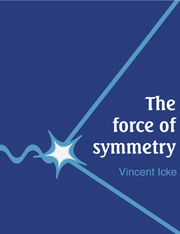Book contents
- Frontmatter
- Contents
- Preface
- Introduction
- 1 A matter of force
- 2 Stalking the wild rainbow
- 3 Light
- 4 Maybe I'm Heisenberg
- 5 Catch a falling quantum
- 6 Quantum beanbags
- 7 Symmetries
- 8 Quantum relativity: nothing is relative
- 9 Life, the Universe and everything
- 10 The physics of a tablecloth
- 11 Colour me red, green and blue
- 12 Smashing symmetry
- 13 How much is infinity minus infinity?
- 14 Excelsior! The ascent to SU(∞)
- A modest reading proposal
- References
- Glossary
- Index
1 - A matter of force
Published online by Cambridge University Press: 05 August 2012
- Frontmatter
- Contents
- Preface
- Introduction
- 1 A matter of force
- 2 Stalking the wild rainbow
- 3 Light
- 4 Maybe I'm Heisenberg
- 5 Catch a falling quantum
- 6 Quantum beanbags
- 7 Symmetries
- 8 Quantum relativity: nothing is relative
- 9 Life, the Universe and everything
- 10 The physics of a tablecloth
- 11 Colour me red, green and blue
- 12 Smashing symmetry
- 13 How much is infinity minus infinity?
- 14 Excelsior! The ascent to SU(∞)
- A modest reading proposal
- References
- Glossary
- Index
Summary
The law of inertia
The way the world works is mostly the way things move: Where is what when? is just about the most basic question one can ask about the Universe. Everyday experience gives us a rough-and-ready answer: the motion of matter is governed by forces. A puck may lie still on the ice until it is struck with a stick, after which it glides straight along until it hits something else. Without being struck, bumped, caught, or otherwise interfered with, it will follow its own path.
This description is horribly vague. On the ice, the puck moves with very nearly constant speed in a straight line. But the same object, struck in the same way, moves very differently on the pavement: almost as soon as the blow that sets it in motion is over, the puck lies still again. At the very least, then, it is unclear what an object's true path is: the smooth gliding along the ice, or the state of rest on the pavement, or what?
We cannot specify what we mean by ‘force’ until we have specified what ideal state of motion that force is supposed to perturb. Some four centuries ago, it was generally assumed that motion with constant speed along a circle is the ideal motion that can maintain itself indefinitely without external influence.
- Type
- Chapter
- Information
- The Force of Symmetry , pp. 1 - 22Publisher: Cambridge University PressPrint publication year: 1995



